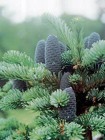Conservation Status

Abies nephrolepis
(Trautvetter) Maximowicz 1866
Common names
Manchurian fir, Hinggan fir, eastern Siberian fir [English]; Пихта белокорая pikhta amurskaya [Russian]; 臭冷杉 chou leng shan [Chinese]; 분비나무 [Korean].
Taxonomic notes
Section Balsamea, subsection Medianae, which it shares with the other east Asian firs A. sachalinensis, A. koreana, and A. veitchii, and the North American species A. fraseri (Farjon 1990).
Synonymy (Farjon 1998):
- Abies sibirica Ledeb. var. nephrolepis Trautv. ex Maxim. 1859
- Abies veitchii Lindl. var. nephrolepis Masters 1880
- Pinus nephrolepis (Trautv. ex Maxim.) Voss 1907
- Abies nephrolepis f. chlorocarpa E.H. Wilson 1920
- Abies koreana E.H. Wilson f. prostrata Kolesn. 1938
Description
Evergreen monoecious trees to 30-35 m tall and 100-120 cm dbh with a round columnar trunk. First-order branches spreading horizontally (ascending in upper crown, drooping in lower) and second-order branches spreading horizontally, to form a conical or oval crown that flattens and may become irregular as the tree ages. Bark first smooth, light gray to gray-brown, fissuring and darkening with age. Twigs slender, firm, yellowish gray-brown turning gray, ridged and grooved with minute pubescence in the grooves, and circular leaf scars. Leaves dull gray-green, spirally arranged, directed forward, obscuring the upper surface of the shoot, 1-2.5(-3) cm × 2 mm, linear, flattened with slightly revolute margins, strongly twisted at base, apex variable: notched to acuminate, stomata in 2 bands on lower surface. Pollen cones lateral, axillary, crowded on underside of foliage, yellow-green. Seed cones lateral, erect, often several crowded together, cylindrical, obtuse, 4.5-7.5 × 2-3.5 cm, purple maturing to dull brown, persistent dark brown conical rachis. Cone scales reniform, 10-12 × 15-18 mm, smooth, resinous, exposed portion puberulent, exposed margin entire or slightly erose. Bract scales 14-20 mm, spathulate, with exserted straight cusps. Seeds obovate-cuneate, 5 × 3 mm, black, with short blackish 6 × 5 mm seed wings (Farjon 1990). See García Esteban et al. (2004) for a detailed characterization of the wood anatomy.
Specimens with green immature cones have been described as forma chlorocarpa Wilson. In Heilongjiang, China, this species hybridizes with Abies sibirica: Abies × sibirico-nephrolepis Takenouchi et Chien. The hybrid has shorter leaves, the young shoots are grey-brown pubescent, and the cones are larger; other characters are intermediate between the two species (Farjon 1990).
Distribution and Ecology
China: Hebei, Heilongjiang, Jilin, Liaoning, Shaanxi; North Korea; South Korea; Russia: SE Siberia, from the Zeya River to the Sikhote Alin Mountains; at elevations varying from 500-700 m near its northern range limits, to 750-2000 m near the southern. Climate cold, with most precipitation falling as snow (Farjon 1990, Fu et al. 1999). Hardy to Zone 3 (cold hardiness limit between -39.9°C and -34.4°C) (Bannister and Neuner 2001).
Soils variable, well-drained. Common associated trees include Picea jezoensis and Pinus koraiensis in maritime areas; in the interior, Picea obovata, Larix gmelinii, Pinus sibirica, Abies sibirica, Betula spp. and Sorbus amurensis. At higher elevations it occurs with Juniperus sabina and Pinus pumila (Farjon 1990).
Remarkable Specimens
A specimen 34 m tall and 220 cm dbh is reportedly grows on the Shkotovo plateau, Ussuriland, Russia (see photograph). Trees with a larger diameter are reported from the vicinity of Lake Aitut near Komsomolsk, in the lower Amur Valley (Vladimir Dinets e-mail 2000.06).
Ethnobotany
No data as of 2023.02.22.
Observations
No data as of 2023.02.22.
Remarks
The epithet nephrolepis is from the Greek, referring to the kidney-shaped cone scales.
Citations
Farjon, Aljos. 1990. Pinaceae: drawings and descriptions of the genera Abies, Cedrus, Pseudolarix, Keteleeria, Nothotsuga, Tsuga, Cathaya, Pseudotsuga, Larix and Picea. Königstein: Koeltz Scientific Books.
See also
Cheng and Fu (1978).
Vidakovic (1991).
Description and illustration at the Flora of China (Fu et al. 1999).


